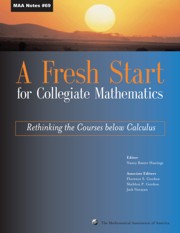Book contents
- Frontmatter
- Preface
- Contents
- Introduction
- Background
- Theme 1 New Visions for Introductory Collegiate Mathematics
- Theme 2 The Transition from High School to College
- 13 High School Overview and the Transition to College
- 14 Precalculus Reform: A High School Perspective
- 15 The Influence of Current Efforts to Improve School Mathematics on the Preparation for Calculus
- Theme 3 The Needs of Other Disciplines
- Theme 4 Student Learning and Research
- Theme 5 Implementation
- Theme 6 Influencing the Mathematics Community
- Ideas and Projects that Work: Part 1
- Ideas and Projects that Work: Part 2
14 - Precalculus Reform: A High School Perspective
from Theme 2 - The Transition from High School to College
- Frontmatter
- Preface
- Contents
- Introduction
- Background
- Theme 1 New Visions for Introductory Collegiate Mathematics
- Theme 2 The Transition from High School to College
- 13 High School Overview and the Transition to College
- 14 Precalculus Reform: A High School Perspective
- 15 The Influence of Current Efforts to Improve School Mathematics on the Preparation for Calculus
- Theme 3 The Needs of Other Disciplines
- Theme 4 Student Learning and Research
- Theme 5 Implementation
- Theme 6 Influencing the Mathematics Community
- Ideas and Projects that Work: Part 1
- Ideas and Projects that Work: Part 2
Summary
In many secondary schools, precalculus reform has preceded calculus reform. Consequently, those of us in the high schools have considerable experience with the capabilities of successful precalculus students in a reformed curriculum and their performance the next year in calculus. From a personal perspective, two important issues are brought forward for consideration.
Successful students in a reformed precalculus curriculum will have new attitudes and abilities that can be utilized successfully in the teaching of calculus.
Reformed precalculus curricula can play an important role in preparing students for the rigor of theoretical mathematics.
Both of these issues have implications in the way the mathematical community views and accepts precalculus reform.
Introduction
At the post-secondary level, precalculus reform is a consequence of successful calculus reform. To the extent that calculus reform has been successful at a university, the modifications in the content and pedagogy of calculus argue for similar modifications in the preparatory precalculus course. However, at the high school level, and particularly at the North Carolina School of Science and Mathematics (NCSSM) where I teach, precalculus reform came first and has been the center of our curriculum for over a decade.
NCSSM opened in 1980 as the nation's first public boarding school for academically talented 11th and 12th grade students who show promise of exceptional development and/or special interest in science and mathematics. The approximately 585 juniors and seniors attending the public high school live in six residence halls on the Durham campus.
- Type
- Chapter
- Information
- A Fresh Start for Collegiate MathematicsRethinking the Courses below Calculus, pp. 121 - 128Publisher: Mathematical Association of AmericaPrint publication year: 2006

